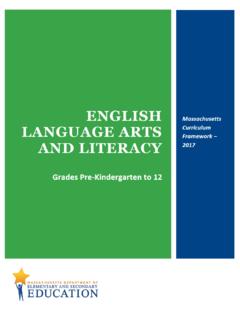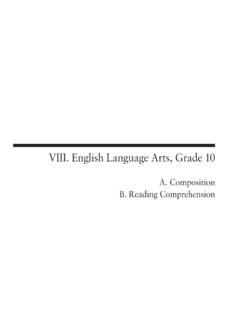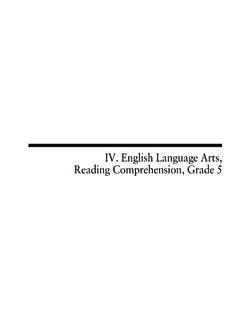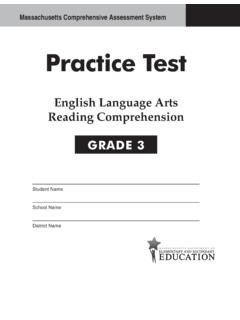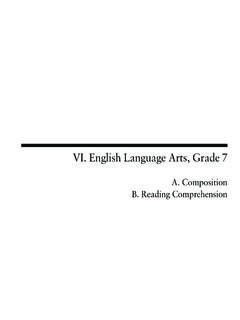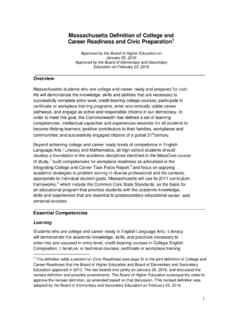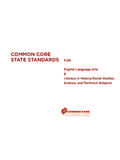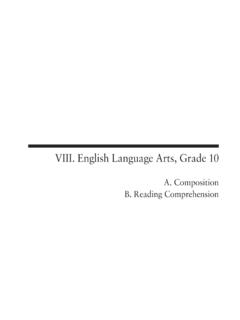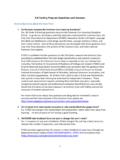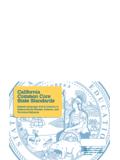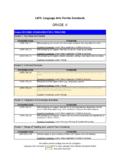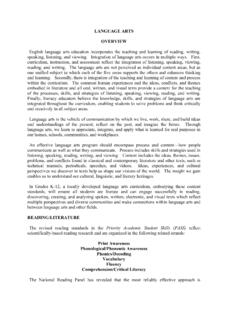Transcription of VII. English Language Arts, Reading Comprehension, Grade 8
1 VII. English Language arts , Reading comprehension , Grade 8 MCAS_2015_Gr8_ELA_RID92 Grade 8 English Language arts Reading comprehension Test The spring 2015 Grade 8 English Language arts Reading comprehension test was based on grades 6 12 learning standards in two content strands of the Massachusetts Curriculum Framework for English Language arts and Literacy (March 2011) listed below. Page numbers for the learning standards appear in parentheses. Reading (Framework, pages 47 52) Language (Framework, pages 64 67)The Massachusetts Curriculum Framework for English Language arts and Literacy is available on the Department website at Reading comprehension test results are reported under two MCAS reporting categories, Reading and Language , which are identical to the two framework content strands listed tables at the conclusion of this chapter indicate each released and unreleased common item s reporting category and the standard it assesses.
2 The correct answers for released multiple-choice questions are also displayed in the released item Sessions and Content OverviewThe Grade 8 ELA Reading comprehension test included two separate test sessions. Each session included Reading passages, followed by multiple-choice and open-response questions. Selected common Reading passages and approximately half of the common test items are shown on the following pages as they appeared in test booklets. Reference MaterialsDuring both ELA Reading comprehension test sessions, the use of bilingual word-to-word dictionaries was allowed for current and former English Language learner students only. No other reference materials were allowed during any ELA Reading comprehension test session. MCAS_2015_Gr8_ELA_RID93 SYMPATHY I know what the caged bird feels, alas! When the sun is bright on the upland slopes; When the wind stirs soft through the springing grass, And the river flows like a stream of glass; 5 When the first bird sings and the first bud opes,1 And the faint perfume from its chalice2 steals I know what the caged bird feels!
3 I know why the caged bird beats his wing Till its blood is red on the cruel bars;10 For he must fly back to his perch and cling When he fain3 would be on the bough4 a-swing; And a pain still throbs in the old, old scars And they pulse again with a keener sting I know why he beats his wing!15 I know why the caged bird sings, ah me, When his wing is bruised and his bosom sore, When he beats his bars and he would be free; It is not a carol of joy or glee, But a prayer that he sends from his heart s deep core,20 But a plea, that upward to Heaven he flings I know why the caged bird sings! Paul Laurence DunbarPaul Laurence Dunbar was an African American poet who wrote in the late 1800s and early 1900s. His poem Sympathy speaks of the feelings of a bird in a cage. Read the poem and answer the questions that follow.
4 Sympathy by Paul Laurence Dunbar. In the public opes opens2 chalice a cup or goblet3 fain gladly4 bough branchGrade 8 English Language ArtsReading CompRehensionDIRECTIONSThis session contains two Reading selections with fourteen multiple-choice questions and two open-response questions. Mark your answers to these questions in the spaces provided in your Student Answer Reading comprehension ID:291936 A Common 1 Which of the following words best describes the feeling created by the description in line 3?A. peacefulB. surprisedC. impatientD. suspensefulID:291938 D Common 2 In line 4, the phrase like a stream of glass suggests the water isA. :291940 B Common 3 In line 5, what do the first bird and the first bud most likely represent?A. the cageB. the springtimeC. the bud s beautyD. the bird s ancestorID:291951 D Common 4 How is the first stanza most different from the rest of the poem?
5 A. The stanza suggests the bird is bored with his The stanza describes how the bird looks, rather than how he The stanza suggests the bird is unwise for wanting his life to The stanza describes what the bird likely desires, rather than what he :291952 C Common 5 Which of the following words best describes the tone of the poem?A. fearfulB. apologeticC. passionateD. wonderingID:291958 D Common 6 Which meaning of the word faint is used in line 6?A. exhaustedB. whisperedC. lacking courageD. barely noticeableMCAS_2015_Gr8_ELA_RID95 ELA Reading comprehension Question 7 is an open-response question. Read the question carefully. Explain your answer. Add supporting details. Double-check your your answer to question 7 in the space provided in your Student Answer :291966 Common 7 Based on the poem, explain why the speaker feels sympathy for the bird. Support your answer with relevant and specific details from the Reading comprehension Eureka!
6 Means I have found it! Read this article about the role that chance has played in important discoveries. Then answer the questions that YOU WOULDN T THINK something as unscientific as accident could have played much of a role in the life of Tim Berners-Lee, the brilliant British physicist and computer scientist who in 1991 invented the World Wide Web. He conceived it and still controls a lot of how it operates from his unimposing office at the Massachusetts Institute of Technology. In 1999, Time placed Berners-Lee on its list of the 100 Persons of the Century. No fewer than seven different universities have awarded him honorary But the great breakthrough engineered by this icon of cyberspace did occur, in part, by chance. There was an element of serendipity, 1 says Arthur Molella, director of the Lemelson Center for the Study of Invention and Innovation at the Smithsonian s National Museum of American History.
7 At first, he was just noodling around, trying to find a way to organize his research files. So he began to develop a tool just for his own personal use. 3 The tool was a software program that, as Berners-Lee puts it, was really useful for keeping track of all the random associations one comes across in real life, and [which] brains are supposed to be so good at remembering but sometimes mine wouldn t. He called it Enquire, and it worked so well, creating effective linkages between huge amounts of information, that it eventually became the basis for the revolution we now casually refer to as the Web. It would be akin to a carpenter building a little cabinet for himself, Molella says, and suddenly discovering he could store the entire world inside the thing. There was quite a bit of luck in it.
8 4 The element of chance has helped produce many of the most important Tim Berners-Lee sought a way to organize his notes. So he created the World Wide Web. But I hate spam, he says, and now directs the W3 Consortium, which regulates the Web and combats cyber !by Ken Chowder1 serendipity finding something valuable without seeking it MCAS_2015_Gr8_ELA_RID97 ELA Reading comprehension innovations in modern life. Many are created by it; others become successful because of it, and some fail for the same reason. As Mark Twain, an inventor himself, once scribbled in his notebook: Name the greatest of all the inventors. Accident. If you don t believe it, go into your kitchen and look around. There might be a Teflon pan on the stove, a microwave oven above it, Post-its sticking out of cookbooks, matches in a drawer; Coke, Popsicles and ketchup stashed in a refrigerator.
9 Accident played a role in their Happenstance 2 works in many ways. One is the observed event: the invention is the way the mind seizes upon an inconspicuous occurrence. The best known of these is Alexander Fleming s role in the discovery of penicillin. One day in 1928 some mold drifted through an open window in a London hospital and landed in Fleming s petri dish, where he d placed a culture of staphylococcus bacteria. What Fleming did next got him and two colleagues a Nobel Prize in 1945: he looked through the microscope. What he saw was the mold efficiently destroying the germs. Presto! The creation of penicillin began with that unlikely turn of But Robert Friedel, historian of technology at the University of Maryland, cautions that serendipity is no accident. What s important about an unintended event, Friedel asserts, is the creative way it is used.
10 As Louis Pasteur once said, Chance favors only the prepared mind. 7 Any of us might happen to see a cat pull feathers through a birdcage; but when Eli Whitney saw that, he got the idea of how to comb cotton mechanically. Hence the cotton gin. Some people are just more likely to pay attention when they see something, says Rini Paiva of the National Inventors Hall of Fame in Akron, Ohio. If you have a certain type of brain, you might see something weird and say, Hey, what can I do with this? 8 Take Percy Lebaron Spencer. A hero of World War II for his work in developing radar, Spencer obtained more than 120 patents in his lifetime. One day shortly after the war, he was walking through his lab at the Raytheon Company in Cambridge, Massachusetts, when he stopped briefly by a magnetron the tube that produces the high-frequency microwaves that power radar.
